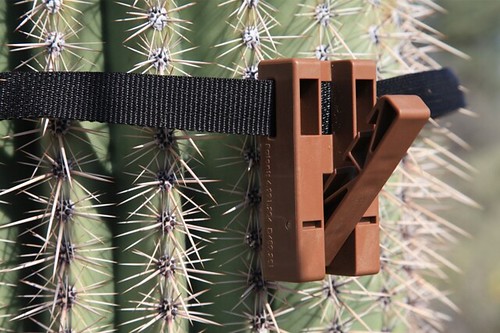
Overland Tech and Travel
Advice from the world's
most experienced overlanders
tests, reviews, opinion, and more
A proper camp breakfast
 GSI Pinnacle griddle on the Snow Peak large Pack and Carry Fireplace with bridge attachment.
GSI Pinnacle griddle on the Snow Peak large Pack and Carry Fireplace with bridge attachment.
Hickory-smoked bacon sizzles on a griddle. The fat pools, spreads, and infuses eggs scambling in butter nearby.
Did your salivary glands just twitch? Of course they did. Any vegans reading this—you had the same reaction. Oh, you might suppress it, pretend it didn’t happen, but somewhere deep down your atavistic omnivore is beseeching you to reject dietary self-flagellation and embrace your rightful place in the food chain.
We all know that eating bacon and eggs on a daily basis is probably not a wise habit—and besides, it wouldn’t be a treat then. But there’s no harm in indulging on a camping trip. Imagine: Dawn breaks over distant peaks, a breeze stirs pine trees overhead, blue jays greet the new day with a raucous chorus, and you stand over a fire with a cup of coffee, inhaling the scent of . . . frying tofu? C’mon.
To do bacon and eggs—and many other proper camping dishes—correctly it’s nice to have a griddle. At home we use cast iron, but that’s a bit heavy for a mobile kitchen when you consider its specialized niche. So we recently tried the Pinnacle Griddle from GSI Outdoors. It’s aluminum and just a bit over two pounds, yet offers a generous 10 by 18-inch cooking area surrounded by a grease moat. The surface is some non-stick space-age stuff—which we eschew at home but which is nice for cleaning up with a limited water supply. The back is hard-anodized (GSI offers a non-anodized version called the Bugaboo).
That one-and-a-quarter square foot size is perfect because, a) when we do eat bacon and eggs we eat a lot, and, b) because it fits nicely over our large Snow Peak Pack and Carry fireplace. (Snow Peak makes a cast iron griddle insert for their fireplace bridge, but it's ridged, and suitable only for cooking meat; we also use our griddle for pancakes and flatbreads.)
 The grease moat keeps excess grease off the main cooking area. On the Snow Peak fireplace bridge, you can carefully slide the griddle to the side and pour off excess into a container.
The grease moat keeps excess grease off the main cooking area. On the Snow Peak fireplace bridge, you can carefully slide the griddle to the side and pour off excess into a container.
Cooking over mesquite coals accomplishes two things. First, it adds to the atmosphere of the experience; second, it keeps that atmosphere out of the camper, where too much bacon grease and smoke too often would not be good for the canopy and upholstery. The griddle also fits in the fireplace’s (insanely obtuse) carrying case.
The Pinnacle Griddle’s aluminum is fairly thin, which means low heat will suffice, but not so thin that there were hotspots—it heated and cooked evenly for both bacon and pancakes. However, the surface of ours also came slightly convexly warped, so that an egg cracked in the middle would sort of elongate toward the edge until corraled with a spatula. I plan to see if it will flatten, using some heavy boards and judicious pressure.
 Cooking eggs and tortillas in the bacon grease. Can life get any better?
Cooking eggs and tortillas in the bacon grease. Can life get any better?
In the meantime, it’s working just fine—and we’ve successfully subverted several vegans at group camps.
Visit GSI here.
Irreducible imperfection: the SOL Origin
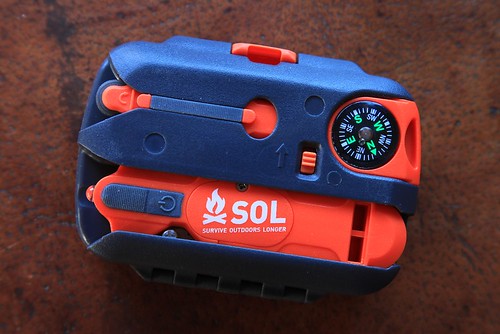
Manufacturing miniature survival kits must be the closest thing to printing your own money short of selling bottled water. I’ve looked at dozens of them, and rarely found contents worth more than about $2.95—usually some fish hooks and monofilament, a few feet of cheap paracord, matches or friction fire starter, a button compass, and a couple of safety pins. Maybe a tiny mirror for signaling. For a while many of them came with a condom, the stated purpose of which was not to provide safe sex with that drooling grizzly bear loping in your direction, but to carry water. Right.
I’ve recently been evaluating the SOL Origin survival kit, which retails for around $40, and I must say the contents of this kit are a step up from some. In fact, I’d say there’s a good six or seven bucks worth of stuff in here.
SOL stands for Survive Outdoors Longer (as well as the banal double entendre). SOL is a division of the parent company that owns Adventure Medical Kits, which I’ll say up front produces some of the very finest expedition first-aid kits, one of which is standard equipment on all our African projects.
The SOL Origin comprises an ABS plastic case enclosing the following:
- Three square feet of aluminum foil—sorry, heavy-duty aluminum foil according to SOL
- A combination knife, LED flashlight, and whistle
- A liquid-filled button compass
- A “Fire Lite” thumb-wheel fire striker
- Four #10 fish hooks
- Fishing line
- Six feet of .020” stainless-steel wire
- Signal mirror
- Two snap swivels
- Two split-shot line weights
- Four pieces of braided “Tinder Quick”
- Sewing needle
- Ten feet of 150-pound-test braided nylon cord
Okay—maybe I was wrong about the six or seven bucks worth of contents. Let’s make it five.
So, what do we have here? I’ll start with the palm-sized case, which for some strange reason comes with a wrist lanyard, as though that’s how you’d carry it around ready for deployment the instant you felt disoriented. The case is constructed in such a way that the knife/flashlight/whistle, the fire striker, and the button compass slide into slots on the outside. This accomplishes several nifty things at once. It increases the chance one or more of those items (the most critical in the kit) will be damaged or come loose and be lost; it severely reduces the internal volume of the case, rendering it unusable for, say, scooping water out of a crevice or digging; and it makes the device look much more tactical, meaning the maker can charge more than if they gave you a simple metal box that could also be used for cooking or boiling water.
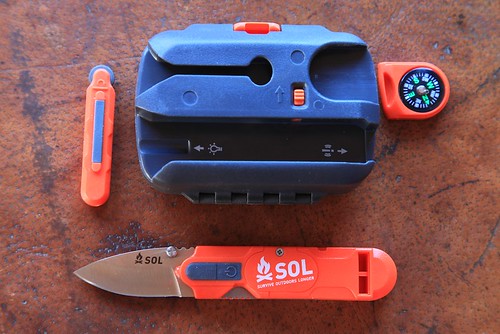 You hope they don't come out of their own volition. The LED bulb is visible at the base of the knife blade; whistle on the other end. Battery compartment is under the "SOL" lettering.
You hope they don't come out of their own volition. The LED bulb is visible at the base of the knife blade; whistle on the other end. Battery compartment is under the "SOL" lettering.
The button compass is simple, well-dampened, and seems to work just fine. Since most people who become lost know more or less in which cardinal direction civilization (or at least the road) lies, it could be a useful tool. There’s a little thumbnail slot in it to facilitate removing it from the case; if this had been pushed through all the way you’d have the option of hanging the compass around your neck on a cord. You could easily drill it out.
The knife blade is 1 3/4 inches long, made from actually-not-bad AUS-8 stainless steel, and is quite sharp. It opens with a right-handed thumb stud, and even locks with a simple Walker liner lock—at least, it’s supposed to. I found that light finger pressure easily overpowered the lock. Best to pretend it’s not there rather than count on it to prevent getting cut. The blade flexes back and forth rather alarmingly on its pivot. The knife would be perfectly functional for gutting a trout or making feather sticks to start a fire, but for anything beyond that—building a shelter, for example—it’s worthless (and I think many so-called survival knives are far too large). The tiny LED flashlight casts a decent keychain-light-level glow and is supposed to shine for 15 hours. There is room in the case for a spare pair of button batteries (which you’d have to buy on your own). But the battery compartment is secured with a tiny Phillips-head screw, so unless you have the means to remove that . . .
The flashlight bulb shines along the axis of the knife, which sort of helps you see what you’re cutting, but it’s not nearly as effective—or as bright—as a separate flashlight would be, even one powered by a single AA battery.
The whistle opposite the knife blade is loud. Just don’t get distracted if you spot a would-be rescuer while whittling a tent peg or something, and stick the wrong end in your mouth.
 Lit - finally - but not much of a flame.
Lit - finally - but not much of a flame.
Next is the fire striker, to be used in conjunction with the four, inch-long bits of braided tinder inside, which appear to be infused with paraffin or something similar. Since, in many if not most survival scenarios, fire is your single most vital survival and signaling (not to mention psychological) tool, one would expect care to be taken here. The striker is said to produce up to 5,000 sparks, but—and this is assuming the thing hasn’t come out of its slot and disappeared—the sparks it generates are nothing like the shower produced by a proper ferrocerium stick. I tried it on one of the pieces of tinder, and it took me two minutes of repeated striking to finally get the cord lit, after which it burned with the strength of a large candle for a bit over two minutes, showing very little resistance to the light breeze that was blowing at the time. I literally used up a hundred or more of those 5,000 sparks to light a manufactured bit of tinder. I wouldn’t even try it on natural tinder. Could the cord have dried out during the time this kit sat on a shelf? Not good if so.
Last on the exterior list is the polycarbonate signal mirror, which hinges off the lid and thus at least can’t be lost easily. The aiming hole in the center of the mirror incorporates retro-reflective mesh, a material that allows extremely accurate aiming. The fold-out “survival pamphlet” in the case includes clear instructions on how to use it—which is lucky, because the graphic under the mirror is utterly incomprehensible. Nevertheless, the mirror is adequately sized and bright, protected from scratching, and undoubtedly the best implement in the kit.
 The signal mirror is a good one, but don't try to figure out how to use it from the graphic.
The signal mirror is a good one, but don't try to figure out how to use it from the graphic.
On to the inside contents. First, the “three square feet” of “heavy-duty” aluminum foil. At 5.5 by 11.5 inches, their math is a bit off, at least for the piece in my kit. My arithmetic comes up with slightly less than half a square foot. Second, I’ve encountered heavier foil wrapped around a stick of Juicy Fruit—this piece came pre-holed on one of the folds. Finally, even the makers seem unsure what to do with the stuff. The pamphlet says, under “Improvisation,” that it “can be used as a reflective device for signaling.” Isn’t the mirror better for that? Another suggested use is as “ . . . a head covering when the night comes on cold.” Okaaaay. So I tried it. I felt like a stick of Juicy Fruit.
 The author, contemplating actually facing the wilderness with this stuff.
The author, contemplating actually facing the wilderness with this stuff.
Onward. Ten feet of braided nylon is perhaps enough to string between two trees to support a poncho or Space Blanket for a shelter. Or you could lash your 1 3/4-inch SOL knife to a stick and go hunting for . . . well . . . chipmunks, perhaps. Or meadowlarks. Twenty feet would have been better, and 20 feet of 550 paracord even better.

Safety pins. Three of them. I want to know: HAS ANYONE IN RECORDED HISTORY EVER NEEDED A SAFETY PIN IN A SURVIVAL SITUATION?
A sewing needle. So you can keep your survival duds neatly mended, or suture the gashes you sustained when that grizzly bear tried to . . . never mind.
Four #10 fish hooks, snap swivels, split shot, and monofilament line. A fine addition to the kit, given the right circumstances of course. In fact, I would have preferred more hooks in different sizes, and more line. The company’s site doesn’t specify the test of the included line, but it appears to be more than adequate for the hook size. It’s up to you to figure out out to crimp the split shot on the line. It’s also up to you to know the proper fisherman’s knot that will secure the slippery monofilament line to the snap swivels; the pamphlet includes none.
Six feet of snare wire (okay, they call it “safety wire,” but the pamphlet suggests using it for snaring). Another fine idea in theory. With a bit of training—and as with the fish hooks, the right habitat—snaring small mammals is a viable survival technique that requires minimal materials and minimal energy expenditure. However, the wire in the SOL Origin was so completely useless for this purpose as to be laughable if the company weren’t touting it as a life-saving device. It was so springy that even after concerted effort I could not straighten it enough to form a stable loop, yet it also kinked horribly. Finally, while holding one end down with a boot and pulling on the other end to try to straighten it, the wire simply snapped at one of the kinks. Not good. Even if the wire were suitable, you need multiple snares to ensure success, and six feet is not enough.
 The worthless- and broken - "safety wire" from the SOL Origin in the middle, with a professionally made wire snare capable of taking small game.
The worthless- and broken - "safety wire" from the SOL Origin in the middle, with a professionally made wire snare capable of taking small game.
Thankfully, that was the last item in the kit, because by this point I was shaking my head in disbelief that the SOL Origin had ever reached the market in this form.
Let’s stop to postulate here. You’re lost in the wilderness. You have no vehicle, no means of communication. Depending on environmental conditions, the next 48 hours will determine whether you live or die. Do you really want to pin your future on a two-inch knife, a plastic spark generator, and some Reynolds Wrap?
Oddly, the kit’s pamphlet (written by Buck Tilton, who should know what he’s talking about, and who calls this “the best little survival kit in the world”) properly identifies survival priorities: positive attitude, medical care, shelter/fire, signaling, water, and food. The SOL Origin fails to address medical care and water at all (not even a few iodine tablets included), is marginal at best on food (worthless snare wire and adequate fishing supplies), and is poor on fire/shelter (build a lean-to with that knife?). Daytime signaling is the only facet that achieves good marks.
I’d even give it a fail on engendering a positive attitude. Given that up to half or more of your time spent lost is going to be at night, with all the attendant practical and psychological implications, the failure to include a proper flashlight is a strong hint that this kit was designed by a designer, not anyone with experience in survival situations.
I could go on to rant about the pamphlet too, but I won’t. Okay, just one: Water. Buck tells us, among other gems, that “ants” mean water is not too far away. I can show Buck lots of ants that don’t live within 50 miles of water. Also, “Birds, especially grain-eating birds, fly to water at dawn and dusk.” Buck, the operative word there is “fly.” And finally he repeats the old saw about “digging at the bends of dry washes.” The only thing you’ll wind up with eleven months of the year if you try that where I live is a pre-excavated grave.
The concept of a palm-sized survival kit is interesting, and I suppose one could argue that the SOL kit is better than nothing at all. But it would be absurdly easy to put together a kit taking up little if any more space, which would be infinitely more useful for saving your life. Yes, it would cost more—if you don’t think your life is worth more than a nice lunch out, I have an SOL Origin I’ll part with for a pittance. As it is, if I somehow found myself caught out with this thing in a survival situation, my first thought would be:
Man, I am SOL.
 Unfortunately, Buck won't be there when you need him.
Unfortunately, Buck won't be there when you need him.
The Cinch to Hang, or Why didn't I think of that?

How many times have you been camping amongst trees and wanted to hang something on one of them—a kitchen utensil roll, a bathroom kit, a shaving mirror, a jacket or hat—and wished there were a nice stub of a branch right . . . there? Just hammering in a nail is considered impolite to the tree these days.
Charles Ay’s solution was clever enough to win two U.S. patents. The Cinch to Hang is a two-ounce plastic device that, when attached to any tree up to three feet in diameter with the included strap, can hold up to 50 pounds on its fold-out hook.
I subjected a sample to a comprehensive evaluation—which took about, oh, five minutes including installing it on the tree. Very simply, it works as advertised. There was no slippage at all with light loads, and the device only migrated down an inch or two even when I grabbed the hook and exerted significant downward force. Hanging something like a full day pack would be no problem. A pair on a pair of trees would comprise a perfect mount for a clothes line. One strapped to a slanting overhead limb would make an ideal lantern hanger.
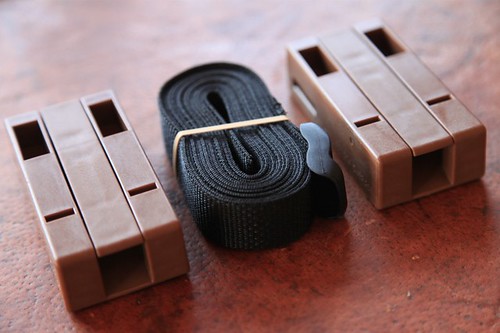
The standard Cinch to Hang kit ($24.95) comes with four hooks and a single strap, but the slot on the hook is one inch wide so it would take any equivalent strap if you want to hang them on different trees. The company’s website is a placeholder (with a photo of the wood prototype) for another week or so, but you can order by email. It’s one of those rare products you’ll truly wonder how you did without. Obviously the Patent Office thought so.
Outdoor Retailer, day 1
Overland Tech and Travel arrived at Outdoor Retailer in sunny Salt Lake City this afternoon. We managed to visit a couple dozen booths before the happy hours began. Over the next three days we will be reporting on new gear as well as just cool stuff. Follow our Flickr Outdoor Retailer set as well (http://www.flickr.com/photos/conserventures/sets/72157630877676310/with/7701752420/).
Here's a preview:
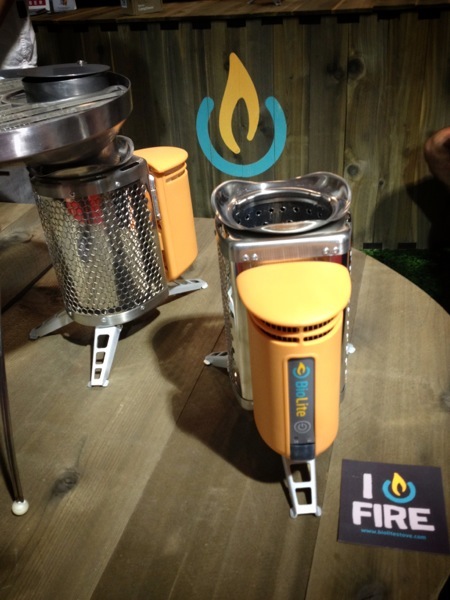
BioLite stove: burns wood (think Kelly kettle on steroids) and generates electricity for charging phones and laptops. Brilliant. A prototype heat-concentrating cooktop, below, was also on display. BioLite.com
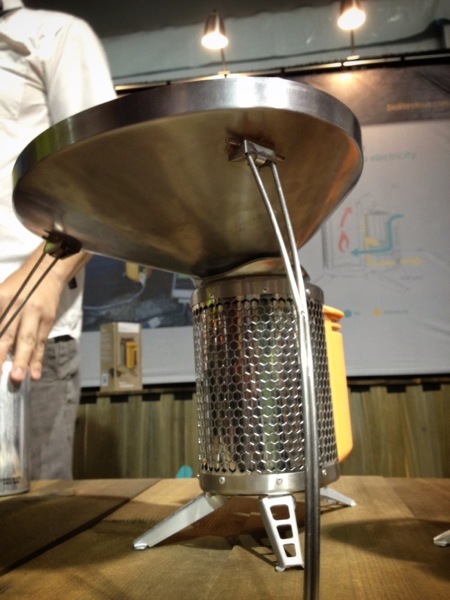
Stealth gray KTM 950 Adventure parked in the shade outside the south entrance.
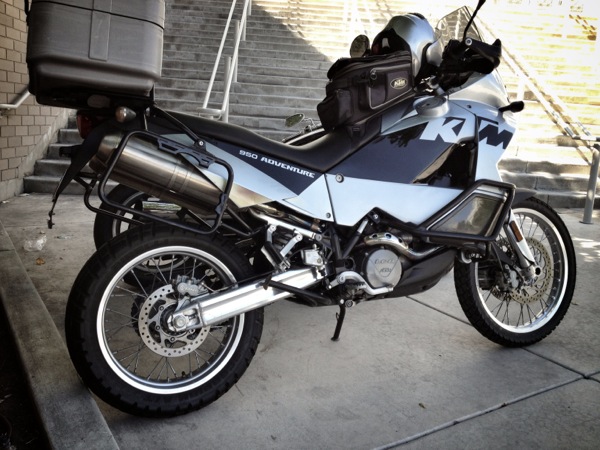
Zippo's beautifully crafted brushed "aluminum" Jeep JK Wrangler, with embossed doors, flame grille, and lighter rear rack box.
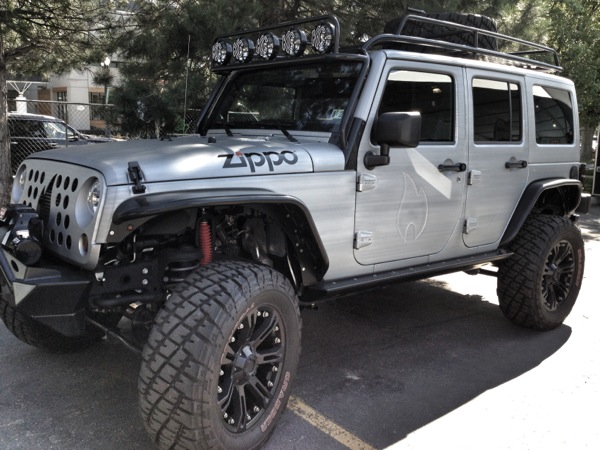
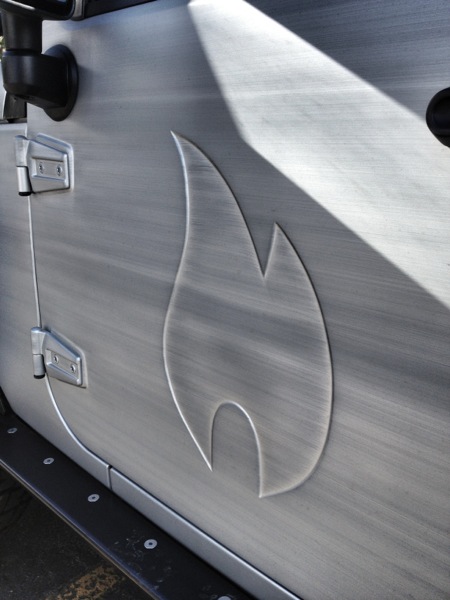
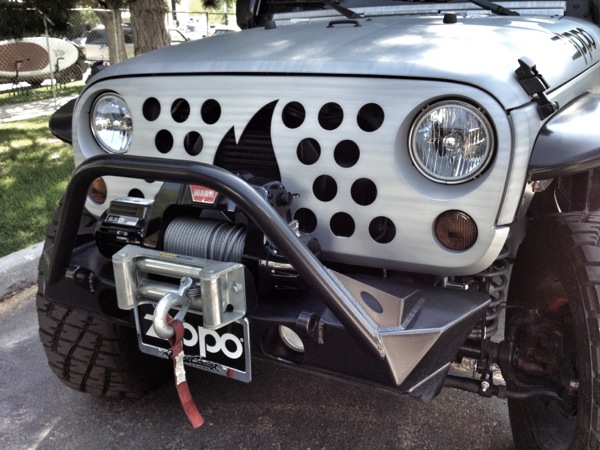
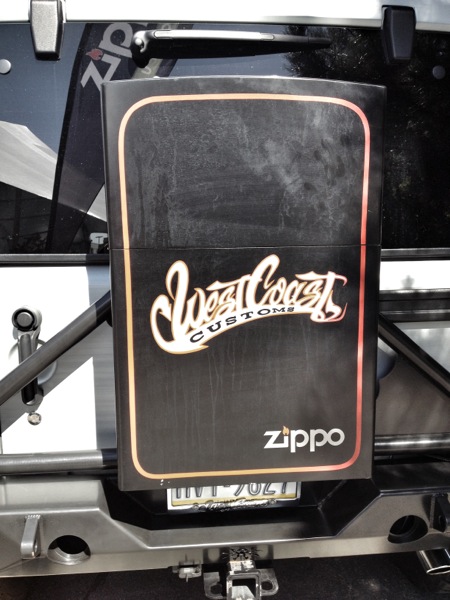
Dahon bicycles fold up into small packages, perfect for overlanding around the globe.
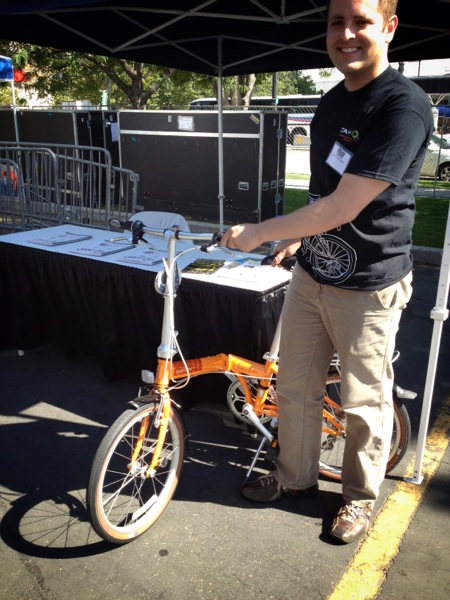
Lifeproof's incredibly slender iPhone case is nevertheless shock-resistant (two-meter drop), dustproof, and waterproof to a depth of six feet - which means your phone will now easily survive being dropped in the toilet.
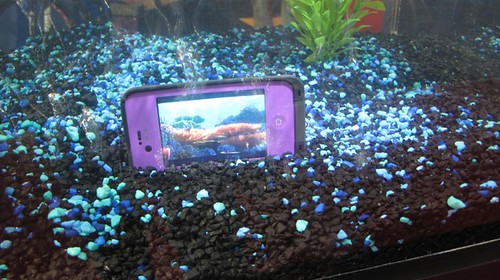
GoPro's display featured this spectacular replica of a legendary Rothmans Paris-Dakar Porsche 911 SC RS.
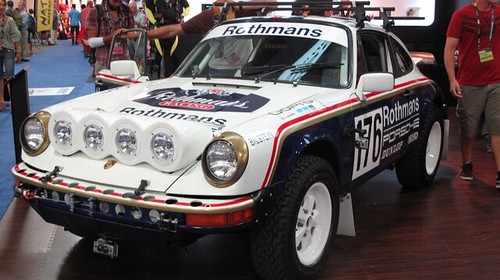
Can't fit the Weber? Bring a SlatGrill
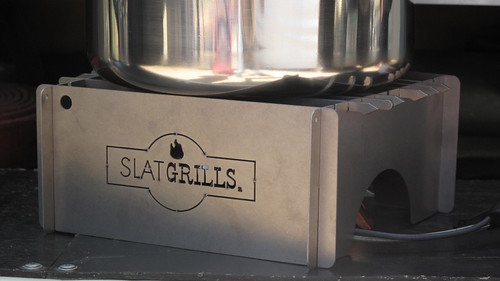
There’s rich irony in the fact that many of us cook on five-foot-wide, $1,500 stainless-steel propane grills in our back yards, where our only view over the wall is the top of the neighbor’s head as he cooks on his own six-foot-wide, $2,000 grill (with counterbalanced rotisserie)—but when we have a brai out in Mother Nature’s beautiful scenery it’s usually on a flat wire grid balanced on rocks, or a theft-proof Forest Service grill with slats spaced 1.5 hot-dog widths apart. Yet short of something like a Belson Porta-Grill:
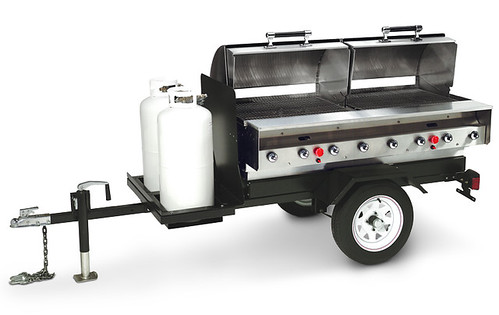
. . . it’s impractical to bring along a proper grill on a wilderness outing. Even a compact Weber charcoal grill takes up a lot of cubic storage space—and it only does one thing.
That’s why Chris Weyandt developed the SlatGrill, a collapsible barbecue that cooks with charcoal or can double as a sturdy pot or griddle support and windscreen for a compact stove.
The SlatGrill comes in sizes ranging from a one-pound titanium model nine inches square to a 75-pound carbon-steel monster with a two-foot by three-foot cooking area. Every one disassembles and stores flat to travel, taking up but a fraction of its assembled volume. Four laser-cut sheets—anodized aluminum, steel, or titanium depending on the model—assemble via corner slots into a square or rectangle. Individual slats then drop into slots in the top; you can space them widely if you want to set a large pot or griddle on top, or close together for grilling.
At the 2012 Overland Expo, Chris handed me one of the compact titanium SlatGrills to try. With the standard three slats, it weighed just under a pound not including the sturdy canvas case. With the addition of three optional slats (highly recommended for versatility) it weighs just ounces more. The assembled grill immediately struck me as a potentially ideal companion to an ultralight remote-canister stove. Such stoves put out heat to rival any full-size propane or white gas stove, but their weak point remains stability and security for large pots—and sometimes, ironically, for very small things such as a two-cup Moka pot, which can fall though the prong spacing. Also, the windscreens for such stoves are often sub-par. It appeared the SlatGrill could solve all these issues.

Indeed it did. I assembled the grill over a JetBoil Helios. The assembly supported with absolute security our largest, four-liter Snow Peak pot full of water, as well as a diminutive Moka pot. And while the clever snap-on windscreen of the Helios is actually pretty effective, it was easily eclipsed by the SlatGrill’s taller walls in an early morning breeze.
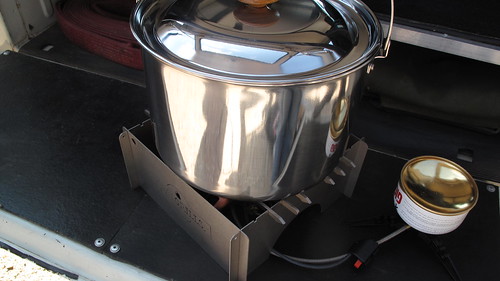
The combination of an ultralight stove and the ultralight SlatGrill creates a versatile cooking system, as at home on a motorcycle with a solo rider as it would be in a full-size four-wheeled vehicle with a small family. If you want two burners, the standard (aluminum) SlatGrill has a 12 by 18-inch surface that would accommodate two compact stoves.
Downsides? The compact titanium model is wincingly expensive at $189. However, a stainless-steel version is available for $69 (and two extra pounds). The mid-size aluminum model is $120; it weighs 3.5 pounds with case. All versions are made in the U.S.
My next step will be to see how the compact SlatGrill works over a little bed of mesquite coals. More soon . . .
Update: Last night I built a compact mesquite fire and let it burn to coals, then dropped the SlatGrill over it and cooked some Andouille sausage. The sides of the grill seemed to concentrate the heat extremely well, and the vent openings on two sides fed the coals the right amount of oxygen to keep them going.
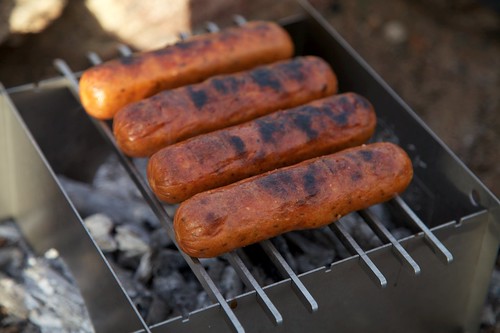
In fact, once the sausages were done there was still enough heat to grill some vegetables.
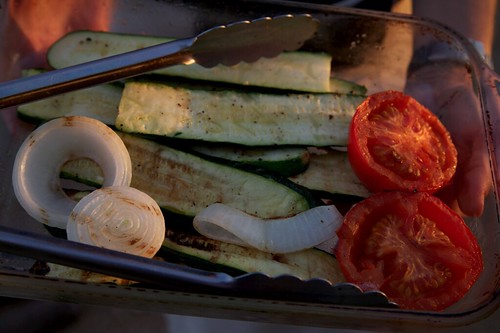
Two issues arose. First, the grill slats are flush with the top of the grill, so there is nothing to prevent a round hot dog rolling off if it's not level or you bump it with the tongs ( you could set hot dogs lengthwise on the slats but it would halve the number that would fit on the grill since they need to be separated by one slat). Also, the lightweight individual slats are easy to knock out of their notches, and can stick to certain foods. I think the latter problem could be solved if I (or the company . . .) drilled holes crosswise in the ends of the slats, then threaded a wire skewer through all of them, one on each side, creating more of a unified platform. The skewer could of course double as a . . . skewer. The rolling-off issue could be mitigated if the slots for the slats were deeper, so the sides made a bit of a lip.
I also decided the six-slat set is the absolute minimum for grilling, to keep the food securely on top, and three more to fill the entire space would have been even better. Of course those little titanium buggers add to the cost quickly; the stainless versions wouldn't hurt so much.
It would be interesting to try a motorcycle or bicycle journey in an area with abundant firewood, using only a SlatGrill for cooking and leaving all the impedimenta associated with a stove at home. Even as a companion to a stove, the compact SlatGrill adds versatility for large pots and the option of open-fire cooking. Well done, SlatGrill.
(Note to self: Avoid punning before coffee.)
Irreducible perfection: The Klean Kanteen insulated bottle
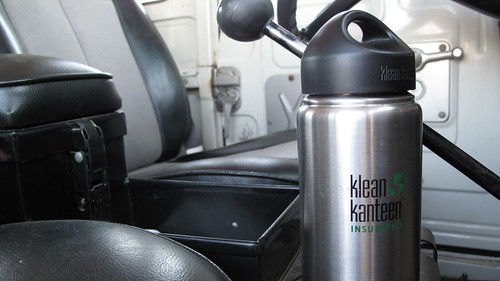
My first canteen was a canteen—a WWII surplus aluminum one-quart M1910 with a chained bakelite cap sealed with a cork gasket. I was seven years old, my family had just moved out to the edge of the desert, and I thought that canteen was the coolest thing on earth (well, except for the sheath knife my stepfather had given me in a bizarre fit of generosity). The canteen and several similar examples served well for countless desert hikes and early backpacking trips into the Catalina Mountains, until replaced with stylish and lighter Olicamp polyethylene bottles, which in their turn were replaced with Nalgene bottles—my resulting antipathy to which is well documented (see here).
In the early 2000s, my search for a better bottle led me to try one of the new stainless-steel Klean Kanteens, despite the fact that that I found the brand name wincingly Kute. The KK, as we’ll call it, seemed to be a vast improvement over the degradation-prone Nalgene. But the “Klean” part of the name was soon called into question when I found that the rolled lip of the bottle, while comfortable to drink from, had a miniscule gap underneath, which after prolonged use resulted in a funky odor that was difficult to exorcise—annoying in a $20 water container. That led to yet more searching, which resulted in an obsession with the even more expensive but indestructible Osprey NATO canteen (more about this in a future article).
However, for some time Roseann has been urging me to try one of Klean Kanteen’s double-walled, vacuum-insulated bottles. A different lip design eliminates the bacteria trap of the original, and the benefit of insulation seems obvious in a desert (although privately I thought the vacuum space pretty thin to be of much value). So, one recent morning when I needed to spend the day in town in the un-air-conditioned FJ40 with a trailer, collecting building materials, and the predicted high was 105º, I filled a 20-ounce insulated KK bottle with water from the fridge and headed in.
Six hours later I hadn’t touched the bottle. All my stops had been places with water fountains, so I’d stayed hydrated. Now, heading west toward home on Highway 86, I was thirsty. The bottle had been in the center console all day, and was now sitting in full sun. The exterior was uncomfortably hot to hold. Okay, now we’ll see, I thought. I opened the lid and took a sip.
The water was . . . cold. Not just nice and cool, but decidedly cold. It was awesome, and I drained most of it in one go.
Suddenly I found myself examining the bottle with new eyes (after I got home, that is). The “Responsibly made in China” label on the bottom made me roll my eyes; however, after reading up on the (still family-owned) company’s site, it does appear they take more care than most to ensure good working conditions in the factory (KK also belongs to the 1% For The Planet project).
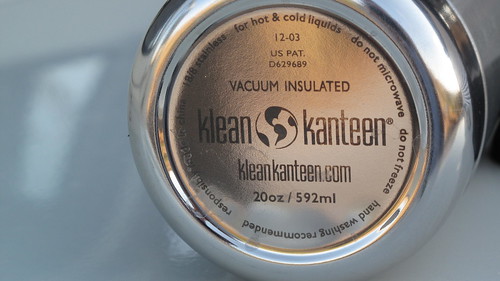
There’s certainly no issue with quality: The bottle is made from 18/8 stainless steel, thick enough that it takes most of my thumb strength to even slightly deflect it. The brushed finish is as even inside as out, and the cap, while obviously not vacuum insulated, does have an air space to help keep contents cold or hot. Sure, I’d be happy if it held more—the 20-ounce size is the largest of KK’s double-walled bottles—but if the bottle were fatter it would be difficult to hold with one hand, and if it were taller it would be unwieldy and unstable. Besides, 20 ounces of cold water feels way more refreshing than a liter of 105º water from my NATO canteen. Titanium option? Well, okay, but titanium, while saving a few ounces, would add hugely to cost, so that’s a tradeoff rather than a failing. I note that the company makes a bicycle cage for the double-walled bottle, which could easily be adapted to suit a motorcycle—nice to have all-day cold water available on a warm ride.
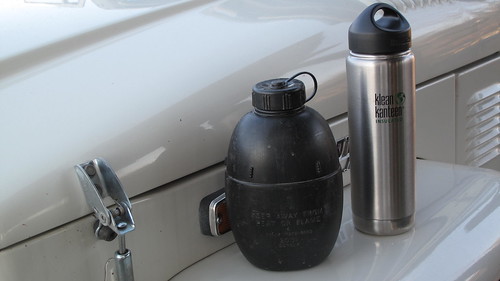 Not as cool as a NATO canteen - but much colder
Not as cool as a NATO canteen - but much colder
Every once in a while I come across a product that defies my best attempts at criticism—when function, style, durability, price, and social responsibility (40 million water bottles go into the trash in the U.S. every day) come together to create what I refer to as irreducible perfection. I have to add the KK double-walled bottle to that short list.
As long as I don’t have to write out the name. Hey, if they made a Kup I could call it the . . . never mind.
A legendary camp chair, resurrected
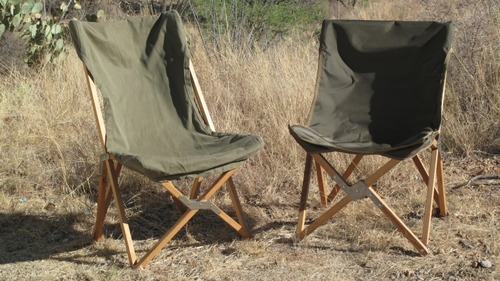 The legendary South African camp chair, left. Its offspring, right.About 20 years ago the owners of a well-known gun shop called Jensen’s, in Tucson, tried to branch out with a line of South African camping equipment: heavy canvas tents, folding sinks, cots, the works—in fact most of the stuff you can easily find today from importers such as Bundu Gear or Equipt. Sadly, Jensen’s was probably 15 years ahead of the curve. Cotton canvas was then considered hopelessly old-fashioned in the U.S., rather than being rightly regarded as a fabric that had stood the test of time and in fact retained several decided advantages over its more modern synthetic substitutes.
The legendary South African camp chair, left. Its offspring, right.About 20 years ago the owners of a well-known gun shop called Jensen’s, in Tucson, tried to branch out with a line of South African camping equipment: heavy canvas tents, folding sinks, cots, the works—in fact most of the stuff you can easily find today from importers such as Bundu Gear or Equipt. Sadly, Jensen’s was probably 15 years ahead of the curve. Cotton canvas was then considered hopelessly old-fashioned in the U.S., rather than being rightly regarded as a fabric that had stood the test of time and in fact retained several decided advantages over its more modern synthetic substitutes.
The store held a close-out sale, at which I noticed a folding wood-framed chair with a ripstop canvas cover. It reminded me of some old and very comfortable steel-framed butterfly chairs my mother had on her patio. I plopped down in one of the South African items, and . . . well, to claim that angels sang might be pushing it, but it was without doubt the most blissful experience I’d ever had in folding camp furniture. (Hmm—reading back over that makes me wonder if I should specify, “ . . . folding camp furniture designed for an upright posture.”). The chair was marked down to $9.95, and there were just four left. I bought all of them.
That lucky find begat something of a legend. Wherever Roseann and I camped, our chairs gathered acolytes faster than a television ministry in Mississippi. Frequently those who sat down “just to try it” could only be removed by threats of violence, including actual displays of edged weaponry. Multiple quests to find similar chairs proved futile, as did multiple quests to find substitutes anywhere near as comfortable. (In the course of searching I learned such chairs were generically called tripolinas and had been designed by an Englishman named Joseph Fenby in 1877.) The closest I came was a spring, 2009 review for Overland Journal, in which I included an outrageous version of the tripolina from safari outfitters Lewis Drake. The Lewis Drake Martin Chair was an exquisite concoction of rosewood, solid brass, and cotton canvas with buffalo-leather trim, and it retailed for $600—a figure that begat its own legend among both connoisseurs and disparagers of safari bling. It was certainly clear that the Lewis Drake chair failed as a remotely affordable alternative to our (admittedly close-out) $9.95 originals—and to be perfectly frank it wasn’t quite as comfortable, being slightly shorter in the seat and lacking their deep, seductive pocket shape.
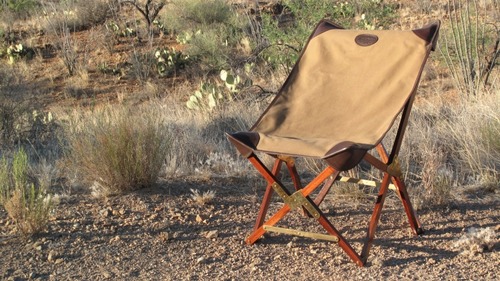 The infamous $600 camp chair. Undeniably a paragon of style.
The infamous $600 camp chair. Undeniably a paragon of style.
In the meantime, Mike Spies, the U.S. distributor of AutoHome roof tents (AutoHome), had visited Roseann and me out in our Sonoran Desert camp-cum-home, and experienced first-hand the soaring notes of a heavenly choir while, from the comfort of a South African tripolina, he watched his English setter chase quail around our yard. On being told the tale, he asked, “Can I borrow one? I’d like to replicate it and put them back into production.” We entrusted one of our irreplaceable chairs to his keeping, and for a full two years received only occasional fractional cryptic updates along the lines of, “Sourcing Sitka spruce from piano industry,” “Searching for U.S. stainless steel fabricator,” and, “Looking into Forest Stewardship Council certification.” A couple of promising prototypes showed up at the 2011 Overland Expo, and this year, finally, I secured a “pre-production” but obviously fully developed example of Mike’s take on the South African tripolina.
It was worth the wait.
Mike clearly was not interested in producing a mere clone. That became obvious before I even saw the chair, when I pulled its 6 by 40-inch carrying case out of the UPS box. It’s sewn from fantastically heavy nylon ballistic cloth, has a handle made from 1.75-inch-wide webbing, and closes with a loop and eyelet system just like the bombproof arrangement of a military duffel bag—and the securing snap on Mike’s bag is solid brass, secured with a leash to the bag to prevent loss. The case is a huge step up from the cheap nylon drawstring sack our old chairs came in.
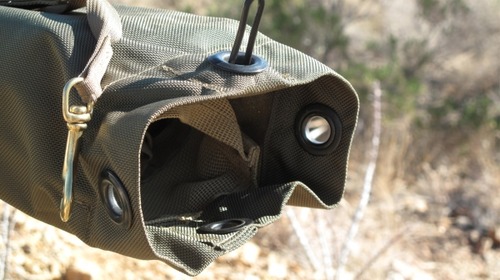 Hook the three grommets over the loop, secure with the brass snap. Bombproof. An internal pocket holds the rolled-up seat cover.
Hook the three grommets over the loop, secure with the brass snap. Bombproof. An internal pocket holds the rolled-up seat cover.
The chair itself lived up to the advance billing of its container. While the line of descent from our South African originals is unmistakable, upgrades are easily seen. The frame pieces—indeed made from Sitka spruce left over from piano manufacturing—are a bit thicker, .87 versus .82 inches, and are just as clear and straight. They appear to have a light oil finish. The folding hardware pieces are stainless steel, the same thickness as the originals (.064”) but much wider, secured similarly with fat rivets. The seat material is the same ballistic nylon as the case, sewn in two pieces to form a perfect pocket, in contrast to the single piece of ripstop cotton canvas used in the old chairs. The edges of both covers are fully bound.
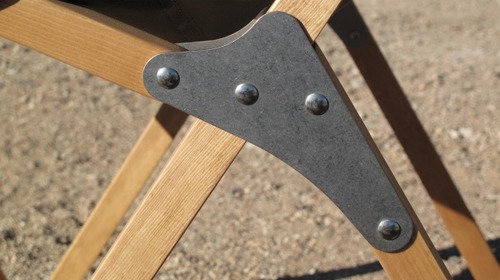 Hardware is stainless steel, broader than the original.
Hardware is stainless steel, broader than the original. 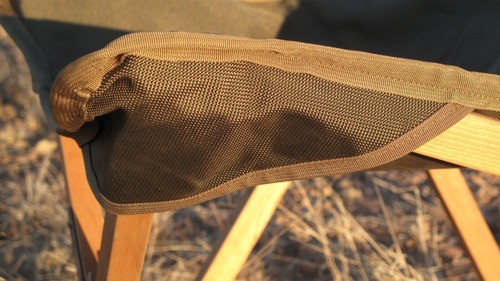 Ballistic nylon seat cover. Edges are fully bound for durability.
Ballistic nylon seat cover. Edges are fully bound for durability.
The more heavy-duty construction showed when I compared weights of just the frames (6.6 versus 5.6 pounds), the chairs with covers (7.4 versus 6.6), and the complete chairs in their cases (8.0 versus 6.8).
But what about actual comfort, the main point of the thing?
Roseann—who has remained faithful to those South African tripolinas for 20 years, no matter what potential rivals I brought home during gear tests—tried one of our veteran examples, then sat in the new one. She went back to the old one, then back to the new one. Finally she took a deep breath and said, “The new one’s better.” I did the same, and said, “Yep. Better.”
Note we said “better,” not “more comfortable.” The reason has to do with the frames. The structure of our South African chairs allows the front of the frame to spread out flat when you erect it. With the cover in place, you first sit down and then draw in the legs to form that deep pocket. Once that’s done, good luck convincing yourself there are camp chores that really need attention. For years I’ve intended to swage and attach a thin steel limiting cable that would tie the front legs together to eliminate the spread (which, to be fair, has undoubtedly worsened as the canvas fabric has stretched slightly over the years).
In Mike’s version, the frame and connecting pieces are constructed in such a way that the legs don’t spread flat, but lock to maintain the proper distance so that the cover automatically assumes the correct, blissful shape. So the two chairs are equally comfortable; the new one simply makes it easier to get there. The back of the new chair is slightly shorter, but neither offers head support for anyone but children, so that’s a wash. In other areas—seat height, back angle, etc.—the two seem interchangeable. Both are better for reclining than sitting upright, but both work just fine for eating or writing at a table as long as the top isn’t too high.
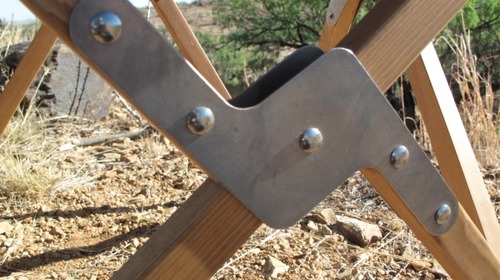 Front hinge plate holds legs in proper position for comfort.In fact I have only one significant gripe: The nylon seat material of the new chair is noticeably less breathable on a warm day than the canvas of the old. The nylon may well prove more durable (although given 20 years and counting on the canvas covers even that might be questionable), but I’d like to see Mike at least offer a cotton option for hot-weather use. He informed me of a couple of other tweaks that will be incorporated in the production chairs: a snap loop or two to prevent the cover being blown off an empty chair, and D-rings for a shoulder strap on the carrying case. Bravo to both.
Front hinge plate holds legs in proper position for comfort.In fact I have only one significant gripe: The nylon seat material of the new chair is noticeably less breathable on a warm day than the canvas of the old. The nylon may well prove more durable (although given 20 years and counting on the canvas covers even that might be questionable), but I’d like to see Mike at least offer a cotton option for hot-weather use. He informed me of a couple of other tweaks that will be incorporated in the production chairs: a snap loop or two to prevent the cover being blown off an empty chair, and D-rings for a shoulder strap on the carrying case. Bravo to both.
Ah, yes—you’ve noted the future tense regarding production chairs. Mine is, as noted, a pre-production model. Mike already has suppliers contracted for the wood, carrying case, seat cover, and metal parts. He’s currently finalizing arrangements to have the wood pieces cut, shaped, drilled, and finished. Once that’s wrapped up he’ll be able to announce prices and availability.
I hope he hurries. There are a lot of people out there still annoyed at me for pulling knives on them.
10 Great Last-minute Christmas Suggestions
Whether your preferred mode is motorcycle, truck, bicycle, or foot, Overland Tech & Travel editor Jonathan Hanson offers up great last-minute gift suggestions for the overlanders on your list—or a treat for yourself.
 Fenix E11 LED microlight ($27)
Fenix E11 LED microlight ($27)
I remember when I thought a halogen flashlight that produced 70 lumens from two expensive lithium batteries (for one hour) was hot stuff. The E11 puts out 105 lumens for almost two hours from a single AA battery—or a walking/reading-level 32 lumens for eight hours on low. Astonishing. Headed to the developing world? Take several—they make genuinely useful trade items or gifts. Fenix
Whether your preferred mode is motorcycle, truck, bicycle, or foot, Overland Tech & Travel editor Jonathan Hanson offers up great last-minute gift suggestions for the overlanders on your list—or a treat for yourself.
 Fenix E11 LED microlight ($27)
Fenix E11 LED microlight ($27)
I remember when I thought a halogen flashlight that produced 70 lumens from two expensive lithium batteries (for one hour) was hot stuff. The E11 puts out 105 lumens for almost two hours from a single AA battery—or a walking/reading-level 32 lumens for eight hours on low. Astonishing. Headed to the developing world? Take several—they make genuinely useful trade items or gifts. Fenix
 Hasyun merino wool underwear (from $43)
Hasyun merino wool underwear (from $43)
I just tried out this very affordable base layer system in 5º Fahrenheit blizzard conditions on a strenuous elk hunt. Verdict: Scrumptious. Wait, I didn’t mean to write that. What I meant was, “Excellent.” Hasyun underwear—made in Turkey since 1952—uses Woolmark accredited extra-fine merino wool from New Zealand. It’s sensuously soft and warm for its weight, machine-washable, and won’t retain odors like that nasty polyester stuff. The small/medium size in both top and bottom fit my 150-pound, 5’9” frame perfectly. Available in both men’s and women’s, imported by a little company that also sells, um, kid’s bicycles. Go figure. Hasyun
 MSR Titan titanium pot ($60)
MSR Titan titanium pot ($60)
Pot, kettle, bowl, mug, scoop—MSR’s brilliant 4.2-ounce Titan pot does it all. It’s the only cook kit you need for a solo motorcycle tour, or a compact coffee-making system for your 4x4. An MSR Pocket Rocket stove and fuel canister ride neatly inside. I’d like to have one of these stashed in every vehicle we own. It should be the official MoMA ultralight cooking pot. Simply perfect.MSR Titan
 Vintage pocket compass ($60-$140)
Vintage pocket compass ($60-$140)
You can employ a vintage pocket compass two ways. Produce it with a flourish from a vest pocket, leashed on a leather cord or—better—a silver chain, and flip open the lid to consult it as Selous might have on his way to the Rufiji River. Or, glance at it surreptitiously, then point to the horizon and say sagely, “That should be north.” Either way your companions will be impressed. I carry my WWII-era Wittnauer version everywhere—it’s especially handy for remaining oriented south of the Equator, where the sun always seems to be in the wrong place. This young woman (Kornelia Takacs, who also wrote the book Compass Chronicles), has a wonderful selection: Vintage compasses
 Helle Temagami ($170)
Helle Temagami ($170)
Everyone should own at least one really good sheath knife—and if it happens to be beautiful as well, all the better. The Temagami (say teh-mah-gah-mee) from Norway is both. A hand-filling, oiled curly birch handle surrounds a superb laminated steel blade—two resilient 18-8 stainless outer layers sandwiching a high-carbon cutting edge. Like all Helle knives, the Temagami comes razor sharp, in a leather sheath that works equally well for right- or left-handers. I’ve included two suppliers: Feathered Friends, who also make some of the best down sleeping bags in the world, and the delightful Ragweed Forge, which you should visit anyway. Feathered Friends Ragweed Forge
 Overland Expo 2012 Gift Certificate ($265)
Overland Expo 2012 Gift Certificate ($265)
Okay, it’s our own event, but after all, think of what you get: Three days of classes & programs (over 80 to choose from); driving instruction from Camel Trophy team members in your own vehicle or a new Land Rover; an all-new Camel Trophy Overland Skills Area where you might, say, learn how to build a bridge to get your 110 across a washed-out ravine; motorcycle instruction from RawHyde Adventures, the official BMW training partner; over 120 vendors & exhibitors of high-quality overlanding products & services; the Adventure Travel Film Festival; happy hours; and a barbecue to wrap it all up. We’ll do up a custom e-Card or printed card. Find out why people come again and again. Overland Expo
 Cerberus (from $499)
Cerberus (from $499)
The era of one-way “I’m okay” or “Help!” global messaging is over. The Cerberus device twins with your smartphone to allow two-way text messaging from anywhere on earth. If a cell network is not available, Cerberus automatically switches to the Iridium satellite network. You can send up to 160-character messages, and receive up to 1600-character messages. In an emergency it allows detailed two-way communication with a 24/7 command center. You can also drop breadcrumbs, and receive customized regional weather and geo-political alerts. We’ll be testing a unit in the Egyptian desert early next year, so that last feature might come in handy. Cerberus
 ARB CKMTA12 air compressor ($540)
ARB CKMTA12 air compressor ($540)
For years, owners of vehicles equipped with ARB’s legendary diff locks have been abusing the tiny little compressors usually supplied to activate them, by adding a connector for filling tires. Surprisingly, they seem to hold up to this quite well, but the process is glacial and the compressors can reach glow-in-the-dark temperatures. The company’s new twin-cylinder compressor will still activate lockers, but its tire-filling and air-tool-operating capacity is in a different universe. It’s fully up to the job of serving as a hard-mounted vehicle-wide air-supply system, with a stout 100-percent duty cycle. (But, really, couldn’t they have just called it the ARB Twin-cylinder Compressor?) ARB
 Goal Zero Sherpa 120 Adventure Kit ($670)
Goal Zero Sherpa 120 Adventure Kit ($670)
Never run out of power again for your laptop, tablet, or phone, with Goal Zero’s 120-watt-hour power pack (AKA lithium iron phosphate battery) and 27-watt folding solar panel—small enough to pack into your panniers. You can also charge the power pack from a wall outlet or cigarette lighter. What impresses me most about Goal Zero is the foolproof plug-and-play nature of their systems, any of which can be effortlessly augmented with additional panels and batteries (or a 120-volt AC inverter). Goal Zero

La Peregrina Natural Pearl Necklace ($3,000,000)
Just seeing if Jonathan is paying attention. (Elizabeth Taylor’s jewelry collection is up for auction at Christie’s; a nice little trinket, this, though not suitable for overlanding in all countries). Christie’s
Hint: When using “Search,” if nothing comes up, reload the page, this usually works. Also, our “Comment” button is on strike thanks to Squarespace, which is proving to be difficult to use! Please email me with comments!
Overland Tech & Travel brings you in-depth overland equipment tests, reviews, news, travel tips, & stories from the best overlanding experts on the planet. Follow or subscribe (below) to keep up to date.
Have a question for Jonathan? Send him an email [click here].
SUBSCRIBE
CLICK HERE to subscribe to Jonathan’s email list; we send once or twice a month, usually Sunday morning for your weekend reading pleasure.
Overland Tech and Travel is curated by Jonathan Hanson, co-founder and former co-owner of the Overland Expo. Jonathan segued from a misspent youth almost directly into a misspent adulthood, cleverly sidestepping any chance of a normal career track or a secure retirement by becoming a freelance writer, working for Outside, National Geographic Adventure, and nearly two dozen other publications. He co-founded Overland Journal in 2007 and was its executive editor until 2011, when he left and sold his shares in the company. His travels encompass explorations on land and sea on six continents, by foot, bicycle, sea kayak, motorcycle, and four-wheel-drive vehicle. He has published a dozen books, several with his wife, Roseann Hanson, gaining several obscure non-cash awards along the way, and is the co-author of the fourth edition of Tom Sheppard's overlanding bible, the Vehicle-dependent Expedition Guide.

